Mongolia developments, Building project news, North Asian design property architects
Mongolia Property Information : Buildings
Architectural Developments – Built Environment Links for Central Asia
post updated 21 September 2024
Mongolian Architecture Designs – chronological list
Contemporary Inner Mongolia Building Designs – recent architectural selection from e-architect below:
Dairy Technology Innovation Centre, Hohhot
Sand Drift Proving Ground, Khanbogd
+++
Mongolia Developments
Contemporary Architecture in East-Central Asia + Key New Property Designs, alphabetical:
National Archaeological Museum
National Cardiovascular Centre Ulan Bator
Ordos 100 Villa Multiplicities
Revolving Sail Bridge in Mongolia
Yellow River Hotel of Jungar Banner
We aim to add more buildings in this Central Asian country soon – submissions are welcome.
Location: Inner Mongolia, Northeastern Asia
Architecture in Northeast Asia
Contemporary Architecture in Northeast Asia – architectural selection below:
Mongolia
Mongolia is a landlocked country in Central Asia. It is bordered by Russia to the north and China to the south, east and west. Ulaanbaatar, the capital and also the largest city, is home to about 45% of the population. Mongolia’s political system is a parliamentary republic.
The area of what is now Mongolia has been ruled by various nomadic empires. In 1206, Genghis Khan founded the Mongol Empire, and his grandson Kublai Khan conquered China to establish the Yuan Dynasty.
After the collapse of the Yuan, the Mongols retreated to Mongolia. In the 16th and 17th centuries, Mongolia came under the influence of Tibetan Buddhism. At the end of the 17th century, all of Mongolia had been incorporated into the area ruled by the Manchu’s Qing Dynasty.
During the collapse of the Qing Dynasty the Mongols established Temporary Government of Khalkha in 1911. On 29 December 1911 Mongolia declared independence from the Qing Dynasty and this National Liberation Revolution ended the Manchu’s rule that lasted 220 years.
The country came under Soviet influence, resulting in the proclamation of the Mongolian People’s Republic as a Soviet satellite state in 1924. After the breakdown of communist regimes in eastern Europe in late 1989, Mongolia had its own democratic revolution in early 1990, leading to a multi-party system, a new constitution of 1992, and transition to a market economy.
Mongolia is the 19th largest country by area and the most sparsely populated independent country in the world, with a population of around 2.9 million people.
It is the world’s second-largest landlocked country after Kazakhstan.
Source: Mongolia
This index page is for architectural projects in this Central – East Asian country on the e-architect website
Inner Mongolian Architecture
Contemporary Mongolia Architecture Designs – a recent selection from e-architect:
CapitaMall Nuohemule, Hohhot, Inner Mongolia
Architecture: CLOU architects

photo : Chill Shine
National Cardiovascular Centre, Ulan Bator, Mongolia
Architects: IDOM

image courtesy of architects practice
Comments / photos for the Mongolia Architecture Information page welcome

